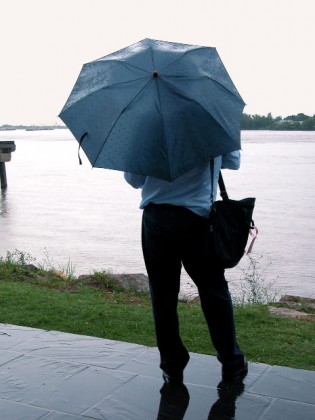In Alberta, a government-approved disaster monthly
Posted on January 24, 2013 By Jeremy Loome Archive, Front Slider, News, news, Politics, The Latest
 If you just looked at the numbers, you might think Alberta is one of the most dangerous places on the planet: after all, the number of natural disasters declared here has increased seventeen-fold in the last 12 years. Floods, fires, hail storms, acts of God that crippled entire industries. We’ve got it all.
If you just looked at the numbers, you might think Alberta is one of the most dangerous places on the planet: after all, the number of natural disasters declared here has increased seventeen-fold in the last 12 years. Floods, fires, hail storms, acts of God that crippled entire industries. We’ve got it all.
But critics think that’s simplistic: let’s face it, says NDP leader Brian Mason, anyone who’s lived in Alberta for the last dozen years knows that, climate change notwithstanding, the number of actual catastrophes hasn’t changed 1,700%.
“I would have to say that the numbers are extremely suspicious,” he said.
So how did Alberta go from just one natural disaster declared in each of 2000 and 2001 to 17 in 2012? It has more to do with politics than weather.
In 2000, the province passed a law called the Fiscal Responsibility Act. It said Alberta couldn’t spend more money than it took in – except in certain emergency circumstances, when it could borrow the money from the province’s long term savings trust fund. The law was designed to bring in balanced budget, but account for massive disasters like the Pine Lake Tornado or the Slave Lake fires.
These days, many of the declarations are from municipalities experiencing a rise in the number of flooded basements, which an Insurance Bureau of Canada report suggests is based on the combination of climate change and aging municipal infrastructure, unable to keep up with increased moisture that backs up sewer lines.
“Canada’s home and business insurers are also seeing an increase in claims resulting from smaller weather events that nevertheless result in significant property damage for consumers. These losses are driven in part by Canada’s aging sewer infrastructure, which is often incapable of handling the new, higher levels of precipitation, while the fact that homeowners are investing more in costly basement upgrades also has an impact on claims. As a result, water claims have now surpassed fire as the number one cause of home insurance losses in many parts of the country,” said the report by Prof. Gordon McBean and colleagues at the Institute for Catastrophic Loss Reduction (ICLR).
Most home insurance policies only cover flooding when it’s caused by sewer backup, due to an overwhelmed municipal system, the report notes.
 Derek Fildebrandt, with the Canadian Taxpayers Federation, calls the government’s acceptance of municipal disaster claims “ridiculous. The government seems to be suggesting that flooded basements are catastrophes. If the bar has been set so low for a catastrophe, we’re going to have to set a new upper standard. Maybe from now on we’ll have to add the category of ‘apocalyptic’. Maybe that will cover the things that are actual natural disasters, and not just excuses for the government to break the budget.”
Derek Fildebrandt, with the Canadian Taxpayers Federation, calls the government’s acceptance of municipal disaster claims “ridiculous. The government seems to be suggesting that flooded basements are catastrophes. If the bar has been set so low for a catastrophe, we’re going to have to set a new upper standard. Maybe from now on we’ll have to add the category of ‘apocalyptic’. Maybe that will cover the things that are actual natural disasters, and not just excuses for the government to break the budget.”
Of course, the IBC report also notes that climate change is leading to a steady rise in the number of actual weather catastrophes. Three of the five most expensive insured loss events in the industry’s history in Alberta occurred during the last five years, and the vast majority of annual government spending goes to major disasters. The Slave Lake fires alone cost government and insurers more than $1 billion combined. That kind of thing makes the public very sympathetic to disaster spending.
“Who doesn’t want to spend money on disasters?” says Fildebrandt. “It just looks good.”
But the IBC report also bases its disaster statistics on those gathered by Public Safety Canada, which charts the impacts everything from terrorism to earthquakes to flood loss. And in the same decade that Alberta’s lieutenant governors signed off on 98 disaster declarations, Public Safety Canada’s disaster database recorded 25.
Alberta Municipal Affairs’ Cam Traynor admits the federal threshold for for a disaster designation is tougher; Alberta’s guide is 20 years old and basically consists of any extraordinary event involving uninsurable loss. He said it’s worth considering whether the Federal government should move for nation-wide definitions of what constitutes a catastrophe.
Mason has often accused the government of being so keen to sell the public on the idea that, under former premiers Ralph Klein and Ed Stelmach, it “paid off” the province’s debt that it quietly ignored capital infrastructure spending, knowing it would cause massive headaches later.
The disaster clause in the Fiscal Accountability Act, which the province repealed in 2010 – gave the government a way to catch up on that spending without having to run deficits publicly, Mason suggested, good for politics optics but bad for the public’s bottom line. The government has as much as $4-billion in infrastructure to catch up on ….but that has declined $2 billion from when it was first identified in the provincial auditor general’s 2007 annual report, the year before the rate of disaster designations accelerated.
“It was obviously just a way around a self-imposed limitation, so that they could spend money on infrastructure, money they should have spent a long time ago,” said Mason. “They simply transferred it from a financial debt to a physical infrastructure debt. But it’s like owning a house: if you save money on upkeep so that you can double your mortgage payments, you may pay it off a bit quicker, but you’re left with an asset that needs so much work, it’s not worth what you paid for it.”
But Traynor says the government has already provided $4-billion through the Municipal Sustainability Initiative over that five-year period to help cover infrastructure costs. The fact that it hands out so much more disaster relief is down to the fact that “the increased awareness of the program has led more and more municipalities to apply and more to be approved.”
Related Links:
Public Safety Canada’s events database:
Alberta government orders in council
Alberta government budget pages
The IBC’s report into the impact of climate change on insurance











![DISASTERSGRAPHICFINAL]](https://www.gigcity.ca/wp-content/uploads/2013/01/DISASTERSGRAPHICFINAL.jpg)


